.gif)
MENU
|
Man in Space
Resource Description |

|
MAN IN SPACE
SITES (continued)
| ROCKET ENGINE TEST STANDS |
These sites represent the role of the Marshall Space Flight Center in the building and testing of actual rocket engines. Before any rocket was flown or used on a manned mission, the engine was test-fired in a static test stand to verify its flight status.
|
Redstone Test Stand, Marshall Space Flight Center Built in 1953, the Redstone test stand (common name--interim test stand) was the first static firing facility at Marshall. It was the first test stand in the United States to accommodate an entire launch vehicle for static tests and was an important facility in developing the Jupiter C and the Mercury-Redstone vehicles that launched Alan Shepard, Gus Grissom, and the first American satellite into space. The Redstone test stand has been preserved in place and has a high degree of integrity. The test stand is inactive and is interpreted on-site by signs and a tour guide. It is part of a bus tour that originates at the nearby Alabama Space and Rocket Center and includes a number of other sites at Marshall. Visitors are allowed to disembark and tour the test stand. The narrated interpretive program is interesting, but it does not describe the role of the test stand in the early American space program. Limited interpretation is also provided at the Alabama Space and Rocket Center, which houses the Marshall visitor center. It is estimated that 130,000 people visited the site on bus tours in 1986. |
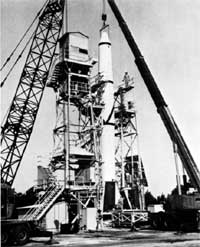 Redstone test stand |
|
Propulsion and Structural Test Facility, Marshall Space Flight Center Built in 1957, the propulsion and structural test facility (common name--solid motor structural test facility) was important in the testing of the Saturn 1B vehicle, and it represents the evolution of test stand technology from the days of the U.S. Army Redstone missile to the solid rocket boosters used on the space shuttle today. The American space program would not have succeeded without the years of testing at this facility. Despite its active status and changes made to accommodate testing of the solid rocket booster, the facility retains much of its original historic fabric. Visitors are not allowed to enter the site, but they can view it from a distance as part of a bus tour. On-site interpretive signing is limited, and the tour narrative does not place the facility in its historical context. Little interpretive information on this facility is provided at the Alabama Space and Rocket Center. Approximately 130,000 people visit the site each year. |
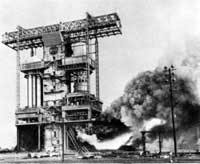 Propulsion and structural test facility, Saturn V F-1 engine testing |
|
Rocket Propulsion Test Complex, National Space Technology Laboratories of the Marshall Space Flight Center The rocket propulsion test complex (common name--A-1/A-2, B-1/B-2 test stands) was built in 1965 and provided the critical final step in certifying the first and second stages of the Saturn V rocket for flight. All Saturn V rockets used in the Apollo program were tested and man-rated for spaceflight here. The stands have been modified for shuttle program activities and are still in use. They are in excellent condition and retain a high degree of integrity. The complex is open to visitors in groups. There is no on-site interpretive media and only limited interpretive material at the National Space Technology Laboratories visitor center. |
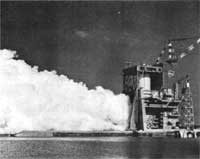 Rocket propulsion test complex, complex A-1 |
| ROCKET TEST FACILITY |
This site represents the role of the Marshall Space Flight Center in the final testing of the moon mission rocket. Tests conducted here gave NASA and industry engineers their last chance to detect and correct any flaws in the fully assembled Saturn V.
|
Saturn V Dynamic Test Stand, Marshall Space Flight Center This test stand (common name--dynamic structural test facility), built in 1964, illustrates another facet of the building, testing, and man-rating of the Saturn V rocket. After every Saturn V was tested on the firing stand, it was brought to the dynamic test stand for mechanical and vibrational tests to determine its structural integrity. Part of the extensive ground testing complex for the Saturn V rocket, it was central to the success of the manned space program. After Saturn V testing was completed, the test stand was modified for testing the space shuttle. It is currently on standby status and retains a high degree of integrity. Visitors are not allowed to enter the site, but they can view it from a distance as part of a bus tour. On-site interpretive signing is limited, and the tour narrative does not place the facility in its historical context. Little interpretive information on this facility is provided at the Alabama Space and Rocket Center. Approximately 130,000 people visit the site each year. |
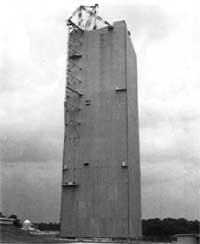 Saturn V dynamic test stand, 1971 |
| ROCKET |
The site displays the space vehicle designed to carry men to the moon.
|
Saturn V Space Vehicle, Alabama Space and Rocket Center On July 16, 1969, a Saturn V space vehicle rose from the launch pad carrying Armstrong, Aldrin, and Collins toward mankind's first expedition to the surface of the moon. Because stages of the Saturn V are not recovered after use, a Saturn V that has actually flown is not available for public viewing. This vehicle was chosen because of its integrity and association with the Marshall Space Flight Center. All three stages of the vehicle and the instrument ring are intact and come from an original test vehicle. It is one of only three remaining Saturn Vs in the country. The space vehicle is well maintained and exhibits a high degree of integrity. It was brought to the Alabama Space and Rocket Center while still active in the program. It is now on loan from the Smithsonian Institution and is displayed in the Alabama Space and Rocket Center's rocket park, which is toured by over 400,000 visitors each year. Informational signs interpret each stage of the rocket as well as the lunar, service, and command modules. The Smithsonian Institution is considering dedesignation procedures to remove this rocket from the National Register because the institution believes that such designation conflicts with its ability to properly manage objects within its collections. |
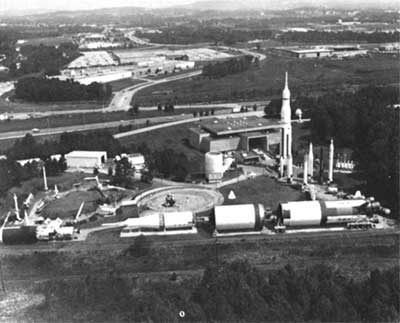
Saturn V space vehicle (before major additions to the
Alabama Space and Rocket Center)
 Top
Top
Last Modified: Wed, Nov 29 2000 10:00:00 am PDT
http://www.cr.nps.gov/history/online_books/butowsky3/space2b.htm
![]()

